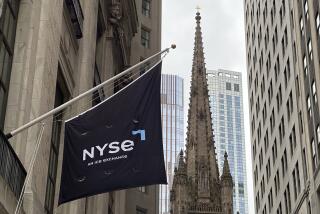Stocks give ground in early trading
Fresh doubts about the economic recovery Wednesday drove U.S. stock prices to their biggest drop in nearly a month and triggered a further pullback in risk-taking worldwide.
On Wall Street, broad market indexes suffered their sixth decline in the last seven sessions, with the Dow Jones industrial average sliding 119.48 points, or 1.2%, to 9,762.69.
The blue-chip Dow fared better than the rest of the market as more investors headed for the exits. Indexes of smaller stocks, for example, slumped more than 3% for the day, though traders said there was no sign of panic selling.
Stocks slid from the opening bell after the government said sales of new homes fell 3.6% in September to a seasonally adjusted annual rate of 402,000 units. Analysts said the unexpected decline -- the first month-to-month drop since March -- probably reflected uncertainty over the fate of the $8,000 federal tax credit for first-time home buyers.
Congress this week is debating whether to extend the credit, which expires Nov. 30.
The downbeat home-sales report added to concerns that the economy’s recovery might be ebbing. On Tuesday, the Conference Board said its index of U.S. consumer confidence fell in October, the second straight monthly decline.
The government today will give its first estimate of third-quarter gross domestic product growth, and Wall Street has been expecting the data to show that the economy expanded for the first time since the second quarter of 2008.
But brokerage Goldman, Sachs & Co. on Wednesday added to investors’ jitters by trimming its third-quarter GDP estimate to an annualized real growth rate of 2.7% from a previous estimate of 3%.
The stock market’s powerful rally from 12-year lows in early March has been rooted in the belief that the recession was ending and that a sustainable recovery was taking hold. Better-than-expected company earnings reports for the second quarter and, this month, for the third quarter have helped pull money back into equities.
But Wall Street has been nagged by worries that the economy could quickly sink without the massive government aid programs that have helped to support the housing and auto markets in particular.
The home-sales data for September showed that “the first-time home buyer credit brought a lot of would-be buyers into the market for affordable housing, but in its wake, the demand for housing slumped just as auto sales tumbled in the aftermath of the cash-for-clunkers program,” said Steven Ricchiuto, chief economist at Mizuho Securities in New York.
Although many other economic reports have been positive in recent months, the stock market’s slide over the last two weeks suggests that more investors are turning wary about the economy’s prospects and are taking some of the profits they’ve racked up since March. Key indexes have rocketed more than 50% from their winter lows.
Art Hogan, chief market analyst at Jefferies & Co. in Boston, said some hedge funds and other investors appeared to be taking the view that this was a good point to lock in gains for 2009 rather than risk watching them evaporate.
“I think some of them just want to wrap it up for the year,” Hogan said.
Banks, energy companies and other commodity producers paced the Standard & Poor’s 500 index’s slump Wednesday, as it lost 20.78 points, or nearly 2%, to 1,042.63. That cut its year-to-date gain to 15.4%.
The tech-dominated Nasdaq composite tumbled 56.48 points, or 2.7%, to 2,059.61. It still is up 30.6% for the year, and up 62% since early March.
The sell-off in stocks has been global since mid-October, and many highflying foreign markets fell more sharply than Wall Street on Wednesday. The German market sank 2.5%, the Brazilian market slid 4.8% and South Korean shares were down 2.4%.
Global investors’ moves to reduce their risk of loss in recent days have helped boost the weakened dollar’s value against other currencies.
The rebound in the greenback, which has mostly been declining since late April, shows that the U.S. currency retains its status as a haven when investors fear that markets could become unglued, traders said.
The euro fell to $1.472 in New York from $1.481 on Tuesday and a high of $1.503 last week.
The rising dollar in turn has undercut prices of commodities. Because most commodities are denominated in dollars, a stronger U.S. currency makes foreign buyers of raw materials willing to pay less in dollars. Near-term crude oil futures slid $2.09 to $77.46 a barrel Wednesday, a two-week low.
Stocks’ woes fed demand for government bonds, as the Treasury auctioned $41 billion in five-year notes. The yield on the benchmark 10-year T-note slipped to 3.40% from 3.46% on Tuesday.
Even as share prices have pulled back since mid-month, major market indexes are down just modestly from their recent highs. The S&P; 500, for example, is off 5% since it reached a one-year closing high of 1,097.91 on Oct. 19.
Many sidelined investors have been waiting in vain since March for a classic market “correction,” meaning a pullback of 10% to 15% in key indexes. The biggest decline in the S&P; was a 7.1% drop from mid-June to mid-July, before buyers swarmed again.
Not surprisingly, talk of a full-blown correction is in vogue again as the market has deteriorated.
Frank Gretz, a technical analyst at Shields & Co., noted that in seven of the last 10 trading days more stocks on the NYSE have fallen than risen. On Nasdaq, decliners have outnumbered advancers on nine of the last 10 days.
“We’re in a correction that has crept up on everyone,” Gretz said. “People were lulled into the idea that we were OK until the end of the year.”
In another worrisome sign, the market has lost ground despite generally strong third-quarter earnings reports, such as those from Apple Inc. and Caterpillar Inc. early last week, Gretz said.
Apple, which fell $4.97 to $192.40 on Wednesday, has dropped 6.2% since peaking at $205.20 last week.
The sell-off has “a little different feel” compared with others since March, said John Wilson, strategist at Morgan Keegan & Co.
“We’re due for a 10% correction at any point.”
--
walter.hamilton@latimes.com
More to Read
Inside the business of entertainment
The Wide Shot brings you news, analysis and insights on everything from streaming wars to production — and what it all means for the future.
You may occasionally receive promotional content from the Los Angeles Times.









